Efficient Adsorption of Arsenic from Smelting Wastewater by CoMn-MOF-74 Bimetallic Composites
Abstract
1. Introduction
2. Materials and Methods
2.1. Materials
2.2. Synthetic Composite Material
2.3. Experimental Procedures
2.4. Batch Adsorption Procedures
3. Results and Discussion
3.1. Characterization of CoMn-MOF-74
3.2. The Effect of Co/Mn Molar Ratio on Arsenic Adsorption
3.3. Effect of Initial pH on the Adsorption of As
3.4. Effect of CoMn-MOF-74 Dosage
3.5. Effect of Adsorption Time and Adsorption Dynamics Research
3.6. Effect of Initial Concentration and Adsorption Isotherms
| Adsorbent | Adsorption Equilibrium Time | pH | qm (mg/g) | Reference |
|---|---|---|---|---|
| Cu-ZIF-8 | 1 h | 7 | 238.11 | [38] |
| MnFe2O4-MIL-53 (Fe) | 4 h | 7 | 402 | [55] |
| NF/MIL-101 (Cr) | 5–20 h | 4 | 132.615 | [56] |
| Zn-MOF-74 | 2.5 h | 7 | 325 | [57] |
| FeCo-MOF-74 | 1 h | 7 | 292.29 | [42] |
| FeMn-MOF-74 | 0.5 h | 7 | 161.6 | [58] |
| Zn-MOF-74/rGO/PAM | 0.5 h | 10 | 282.4 | [59] |
| CoMn-MOF-74 | 0.5 h | 11 | 531 | This work |
3.7. Adsorption and Regeneration Cycle Experiment
4. Reaction Mechanism of Arsenic Adsorption
5. Conclusions
Author Contributions
Funding
Institutional Review Board Statement
Informed Consent Statement
Data Availability Statement
Conflicts of Interest
References
- Yu, B.; Dong, Q.; Zhang, M.; Wang, D.; Li, J.; Cheng, Y. Study on the Effect of Thermal Activation on Arsenic Removal from Industrial Wastewater. JOM 2024, 76, 1539–1547. [Google Scholar] [CrossRef]
- Abdollahi, N.; Moussavi, G.; Giannakis, S. A Review of Heavy Metals’ Removal from Aqueous Matrices by Metal-Organic Frameworks (MOFs): State-of-the Art and Recent Advances. J. Environ. Chem. Eng. 2022, 10, 107394. [Google Scholar] [CrossRef]
- Abhyankar, L.N.; Jones, M.R.; Guallar, E.; Navas-Acien, A. Arsenic Exposure and Hypertension: A Systematic Review. Environ. Health Perspect. 2011, 120, 494–500. [Google Scholar] [CrossRef]
- Yu, H.-S.; Lee, C.-H.; Chen, G.-S. Peripheral Vascular Diseases Resulting from Chronic Arsenical Poisoning. J. Dermatol. 2002, 29, 123–130. [Google Scholar] [CrossRef]
- Li, Y.; Zhu, X.; Qi, X.; Shu, B.; Zhang, X.; Li, K.; Wei, Y.; Hao, F.; Wang, H. Efficient Removal of Arsenic from Copper Smelting Wastewater in Form of Scorodite Using Copper Slag. J. Clean. Prod. 2020, 270, 122428. [Google Scholar] [CrossRef]
- Zakhar, R.; Derco, J.; Čacho, F. An overview of main arsenic removal technologies. Acta Chim. Slovaca 2018, 11, 107–113. [Google Scholar] [CrossRef]
- Asere, T.G.; Stevens, C.V.; Du Laing, G. Use of (Modified) Natural Adsorbents for Arsenic Remediation: A Review. Sci. Total Environ. 2019, 676, 706–720. [Google Scholar] [CrossRef]
- Huling, J.R.; Huling, S.G.; Ludwig, R. Enhanced Adsorption of Arsenic through the Oxidative Treatment of Reduced Aquifer Solids. Water Res. 2017, 123, 183–191. [Google Scholar] [CrossRef]
- Han, Y.-S.; Gallegos, T.J.; Demond, A.H.; Hayes, K.F. FeS-Coated Sand for Removal of Arsenic(III) under Anaerobic Conditions in Permeable Reactive Barriers. Water Res. 2011, 45, 593–604. [Google Scholar] [CrossRef]
- Chai, L.; Yue, M.; Yang, J.; Wang, Q.; Li, Q.; Liu, H. Formation of Tooeleite and the Role of Direct Removal of As(III) from High-Arsenic Acid Wastewater. J. Hazard. Mater. 2016, 320, 620–627. [Google Scholar] [CrossRef]
- An, B.; Liang, Q.; Zhao, D. Removal of Arsenic(V) from Spent Ion Exchange Brine Using a New Class of Starch-Bridged Magnetite Nanoparticles. Water Res. 2011, 45, 1961–1972. [Google Scholar] [CrossRef] [PubMed]
- Wang, Y.; Liu, H.; Wang, S.; Li, X.; Wang, X.; Jia, Y. Simultaneous Removal and Oxidation of Arsenic from Water by δ-MnO2 Modified Activated Carbon. J. Environ. Sci. 2020, 94, 147–160. [Google Scholar] [CrossRef]
- Cai, G.; Tian, Y.; Li, D.; Zhang, J.; Li, L.; Wang, Q.; Sun, H.; Zhang, H.; Wang, P. Self-Enhanced and Efficient Removal of As(III) from Water Using Fe–Cu–Mn Composite Oxide under Visible-Light Irradiation: Synergistic Oxidation and Mechanisms. J. Hazard. Mater. 2022, 422, 126908. [Google Scholar] [CrossRef] [PubMed]
- Huang, X.; Huang, L.; Arulmani, S.R.B.; Yan, J.; Li, Q.; Tang, J.; Wan, K.; Zhang, H.; Xiao, T.; Shao, M. Research Progress of Metal Organic Frameworks and Their Derivatives for Adsorption of Anions in Water: A Review. Environ. Res. 2022, 204, 112381. [Google Scholar] [CrossRef]
- Islam, A.; Teo, S.H.; Ahmed, M.T.; Khandaker, S.; Ibrahim, M.L.; Vo, D.-V.N.; Abdulkreem-Alsultan, G.; Khan, A.S. Novel Micro-Structured Carbon-Based Adsorbents for Notorious Arsenic Removal from Wastewater. Chemosphere 2021, 272, 129653. [Google Scholar] [CrossRef]
- Soni, R.; Shukla, D.P. Data on Arsenic(III) Removal Using Zeolite-Reduced Graphene Oxide Composite. Data Brief 2019, 22, 871–877. [Google Scholar] [CrossRef]
- Lu, Z.; Li, X.; Qi, X. Cobalt-Loaded Resin Can Effectively Remove Arsenic in Wastewater. Environ. Technol. Innov. 2021, 21, 101354. [Google Scholar] [CrossRef]
- Li, Y.; Li, S.; Hu, B.; Zhao, X.; Guo, P. FeOOH and nZVI Combined with Superconducting High Gradient Magnetic Separation for the Remediation of High-Arsenic Metallurgical Wastewater. Sep. Purif. Technol. 2022, 285, 120372. [Google Scholar] [CrossRef]
- Gendy, E.A.; Ifthikar, J.; Ali, J.; Oyekunle, D.T.; Elkhlifia, Z.; Shahib, I.I.; Khodair, A.I.; Chen, Z. Removal of Heavy Metals by Covalent Organic Frameworks (COFs): A Review on Its Mechanism and Adsorption Properties. J. Environ. Chem. Eng. 2021, 9, 105687. [Google Scholar] [CrossRef]
- Zhang, Y.; Zhang, S.; Lin, Y.; Wu, S.; Li, X.; Yang, C. Simultaneous Removal of Heavy Metals and Antibiotics from Anaerobically Digested Swine Wastewater via Functionalized Covalent Organic Frameworks. Environ. Res. 2025, 272, 121152. [Google Scholar] [CrossRef]
- Yang, C.; Xue, Z.; Wen, J. Recent Advances in MOF-Based Materials for Remediation of Heavy Metals and Organic Pollutants: Insights into Performance, Mechanisms, and Future Opportunities. Sustainability 2023, 15, 6686. [Google Scholar] [CrossRef]
- Amari, A.; Alawameleh, H.S.K.; Isam, M.; Maktoof, M.A.J.; Osman, H.; Panneerselvam, B.; Thomas, M. Thermodynamic Investigation and Study of Kinetics and Mass Transfer Mechanisms of Oily Wastewater Adsorption on UIO-66–MnFe2O4 as a Metal–Organic Framework (MOF). Sustainability 2023, 15, 2488. [Google Scholar] [CrossRef]
- Liu, H.; Xiao, B.; Zhao, Y.; Wang, W.; Jia, Q. Adsorption of Heavy Metals with Hyper Crosslinked Polymers: Progress, Challenges and Perspectives. Chin. Chem. Lett. 2024, 110619. [Google Scholar] [CrossRef]
- Patra, K.; Pal, H. Recent Advances in Porous Organic Polymers (POPs): The Emerging Sorbent Materials with Promises towards Toxic and Radionuclides Metal Ions Separations. Mater. Today Sustain. 2024, 27, 100799. [Google Scholar] [CrossRef]
- Zhang, F.; Cui, P.; Zhu, L.; Hua, M.; Huang, Y.; Chao, Y.; Wu, P.; Qiu, Z.; Zhu, W. Construction of Hydrophilic Hydroxyl-Rich Porous Organic Polymers for Efficient Removal of Heavy Metal Ions. Inorg. Chem. Commun. 2023, 153, 110821. [Google Scholar] [CrossRef]
- Kreno, L.E.; Leong, K.; Farha, O.K.; Allendorf, M.; Van Duyne, R.P.; Hupp, J.T. Metal–Organic Framework Materials as Chemical Sensors. Chem. Rev. 2012, 112, 1105–1125. [Google Scholar] [CrossRef] [PubMed]
- Jayaramulu, K.; Dubal, D.P.; Schneemann, A.; Ranc, V.; Perez-Reyes, C.; Stráská, J.; Kment, Š.; Otyepka, M.; Fischer, R.A.; Zbořil, R. Shape-Assisted 2D MOF/Graphene Derived Hybrids as Exceptional Lithium-Ion Battery Electrodes. Adv. Funct. Mater. 2019, 29, 1902539. [Google Scholar] [CrossRef]
- Yang, J.; Yang, Y.-W. Metal–Organic Frameworks for Biomedical Applications. Small 2020, 16, 1906846. [Google Scholar] [CrossRef] [PubMed]
- Rational Approach to Guest Confinement Inside MOF Cavities for Low-Temperature Catalysis|Nature Communications. Available online: https://www.nature.com/articles/s41467-019-08972-x (accessed on 21 October 2024).
- Wang, Y.; Jin, H.; Ma, Q.; Mo, K.; Mao, H.; Feldhoff, A.; Cao, X.; Li, Y.; Pan, F.; Jiang, Z. A MOF Glass Membrane for Gas Separation. Angew. Chem. Int. Ed. 2020, 59, 4365–4369. [Google Scholar] [CrossRef]
- MOF-Derived Porous Carbon-Supported Bimetallic Fischer–Tropsch Synthesis Catalysts|Industrial & Engineering Chemistry Research. Available online: https://pubs.acs.org/doi/10.1021/acs.iecr.1c03810 (accessed on 21 October 2024).
- Zhang, X.; Luo, J.; Wan, K.; Plessers, D.; Sels, B.; Song, J.; Chen, L.; Zhang, T.; Tang, P.; Morante, J.R.; et al. From Rational Design of a New Bimetallic MOF Family with Tunable Linkers to OER Catalysts. J. Mater. Chem. A 2019, 7, 1616–1628. [Google Scholar] [CrossRef]
- A Novel Ag/Zn Bimetallic MOF as a Superior Sensitive Biosensing Platform for HCV-RNA Electrochemical Detection—ScienceDirect. Available online: https://www.sciencedirect.com/science/article/pii/S0169433221012782?via%3Dihub (accessed on 21 October 2024).
- Chen, H.; Huo, Y.-q.; Cai, K.; Teng, Y. Controllable Preparation and Capacitance Performance of Bimetal Co/Ni-MOF. Synth. Met. 2021, 276, 116761. [Google Scholar] [CrossRef]
- Jian, M.; Wang, H.; Liu, R.; Qu, J.; Wang, H.; Zhang, X. Self-assembled one-dimensional MnO2@zeolitic imidazolate framework-8 nanostructures for highly efficient arsenite removal. Environ.Sci. Nano 2016, 3, 1186–1194. [Google Scholar] [CrossRef]
- Li, D.; Li, N.; Liu, W.; Xu, S.; Sun, Y.; Qiao, Z.; Zhong, C. Highly Water-Stable MOF-74 Synthesized by in-Situ Trace Polymer Modification. Polymer 2023, 281, 126112. [Google Scholar] [CrossRef]
- Jiang, H.; Niu, Y.; Wang, Q.; Chen, Y.; Zhang, M. Single-Phase SO2-Resistant to Poisoning Co/Mn-MOF-74 Catalysts for NH3-SCR. Catal. Commun. 2018, 113, 46–50. [Google Scholar] [CrossRef]
- Wang, H.; Qi, X.; Yan, G.; Shi, J. Copper-Doped ZIF-8 Nanomaterials as an Adsorbent for the Efficient Removal of As(V) from Wastewater. J. Phys. Chem. Solids 2023, 179, 111408. [Google Scholar] [CrossRef]
- Huang, P.; Qi, X.; Duan, X.; Jiang, W.; Yang, N.; Zhi, G.; Wang, J. Efficient Arsenate Capture Using Mixed-Metal La/Zr-MOF Internal Complexation. New J. Chem. 2024, 48, 5311–5325. [Google Scholar] [CrossRef]
- Jiang, N.; Du, B.; Gao, D.; Chai, Z.; Liu, C.; Zhu, X. Effective As(V) Removal Using in Situ Grown Ti-Based MOFs on ZnAl-LDHs. Mater. Sci. Eng. B 2024, 303, 117306. [Google Scholar] [CrossRef]
- Wen, Q.; Li, D.; Li, H.; Long, M.; Gao, C.; Wu, L.; Song, F.; Zhou, J. Synergetic Effect of Photocatalysis and Peroxymonosulfate Activated by Co/Mn-MOF-74@g-C3N4 Z-Scheme Photocatalyst for Removal of Tetracycline Hydrochloride. Sep. Purif. Technol. 2023, 313, 123518. [Google Scholar] [CrossRef]
- Sun, J.; Zhang, X.; Zhang, A.; Liao, C. Preparation of Fe–Co Based MOF-74 and Its Effective Adsorption of Arsenic from Aqueous Solution. J. Environ. Sci. 2019, 80, 197–207. [Google Scholar] [CrossRef]
- Qu, G.; Jia, P.; Zhang, T.; Li, Z.; Chen, C.; Zhao, Y. UiO-66(Zr)-Derived t-Zirconia with Abundant Lattice Defect for Remarkably Enhanced Arsenic Removal. Chemosphere 2022, 288, 132594. [Google Scholar] [CrossRef]
- Li, Z.; Deng, S.; Yu, G.; Huang, J.; Lim, V.C. As(V) and As(III) Removal from Water by a Ce–Ti Oxide Adsorbent: Behavior and Mechanism. Chem. Eng. J. 2010, 161, 106–113. [Google Scholar] [CrossRef]
- Prola, L.D.T.; Machado, F.M.; Bergmann, C.P.; de Souza, F.E.; Gally, C.R.; Lima, E.C.; Adebayo, M.A.; Dias, S.L.P.; Calvete, T. Adsorption of Direct Blue 53 Dye from Aqueous Solutions by Multi-Walled Carbon Nanotubes and Activated Carbon. J. Environ. Manag. 2013, 130, 166–175. [Google Scholar] [CrossRef] [PubMed]
- Prasad Panda, A.; Giri, M.; Jena, K.K.; Alhassan, S.M.; Kumar, S.A.; Jha, U.; Swain, S.K. Understanding the As(III) Oxidative Performance of MnO2 Polymorphs (α, β, and γ) and Synthesis of an Efficient Nanocomposite of Iron Ore Slime Derived 2-Line Ferrihydrite and γ-MnO2 for Sequestration of Total Arsenic from Aqueous Solution. Chem. Eng. J. 2022, 442, 136075. [Google Scholar] [CrossRef]
- Huang, Q.; Jiang, X.; Xiong, J.; Zhou, Q.; Zhu, Y.; Xie, Q.; Wang, S.; Yang, X.; Jiang, F. Aspartic Acid Derivative-Based MOFs: A Promising Green Material for Simultaneous Removal of Phosphorus and Arsenic(V) in Contaminated Spring Water. J. Water Process Eng. 2023, 52, 103547. [Google Scholar] [CrossRef]
- Weber, W.J., Jr.; Morris, J.C. Kinetics of Adsorption on Carbon from Solution. J. Sanit. Eng. Div. 1963, 89, 31–59. [Google Scholar]
- Pang, D.; Wang, C.-C.; Wang, P.; Liu, W.; Fu, H.; Zhao, C. Superior Removal of Inorganic and Organic Arsenic Pollutants from Water with MIL-88A(Fe) Decorated on Cotton Fibers. Chemosphere 2020, 254, 126829. [Google Scholar] [CrossRef]
- Gopi, S.; Ramu, A.G.; Yun, K. A Highly Stable Mesoporous Spinel Ferrite (CoxFe3−xO4) Derived from CoFe-MOF for Efficient Adsorption of Ultratrace As(III) Ions from Aqueous Solution. J. Environ. Chem. Eng. 2023, 11, 110106. [Google Scholar] [CrossRef]
- Guo, Q.; Li, Y.; Zheng, L.-W.; Wei, X.-Y.; Xu, Y.; Shen, Y.-W.; Zhang, K.-G.; Yuan, C.-G. Facile Fabrication of Fe/Zr Binary MOFs for Arsenic Removal in Water: High Capacity, Fast Kinetics and Good Reusability. J. Environ. Sci. 2023, 128, 213–223. [Google Scholar] [CrossRef]
- Chen, Y.; Tang, J.; Wang, S.; Zhang, L.; Sun, W. Bimetallic Coordination Polymer for Highly Selective Removal of Pb(II): Activation Energy, Isosteric Heat of Adsorption and Adsorption Mechanism. Chem. Eng. J. 2021, 425, 131474. [Google Scholar] [CrossRef]
- Ezzati, R. Derivation of Pseudo-First-Order, Pseudo-Second-Order and Modified Pseudo-First-Order Rate Equations from Langmuir and Freundlich Isotherms for Adsorption. Chem. Eng. J. 2020, 392, 123705. [Google Scholar] [CrossRef]
- Chaudhry, S.A.; Ahmed, M.; Siddiqui, S.I.; Ahmed, S. Fe(III)–Sn(IV) Mixed Binary Oxide-Coated Sand Preparation and Its Use for the Removal of As(III) and As(V) from Water: Application of Isotherm, Kinetic and Thermodynamics. J. Mol. Liq. 2016, 224, 431–441. [Google Scholar] [CrossRef]
- Yan, G.; Qi, X.; Wang, H.; Shi, J. Magnetic MnFe2O4-MIL-53 (Fe) Composite as an Effective Adsorbent for As(V) Adsorption in Wastewater. Microporous Mesoporous Mater. 2022, 346, 112290. [Google Scholar] [CrossRef]
- Zhi, G.; Qi, X.; Li, Y.; Wang, J.; Wang, J. Efficient Treatment of Smelting Wastewater: 3D Nickel Foam @MOF Shatters the Previous Limitation, Enabling High-Throughput Selective Capture of Arsenic to Form Non-Homogeneous Nuclei. Sep. Purif. Technol. 2024, 328, 124927. [Google Scholar] [CrossRef]
- Yu, W.; Luo, M.; Yang, Y.; Wu, H.; Huang, W.; Zeng, K.; Luo, F. Metal-Organic Framework (MOF) Showing Both Ultrahigh As(V) and As(III) Removal from Aqueous Solution. J. Solid State Chem. 2019, 269, 264–270. [Google Scholar] [CrossRef]
- Zhang, T.; Wang, J.; Zhang, W.; Yang, C.; Zhang, L.; Zhu, W.; Sun, J.; Li, G.; Li, T.; Wang, J. Amorphous Fe/Mn Bimetal–Organic Frameworks: Outer and Inner Structural Designs for Efficient Arsenic(III) Removal. J. Mater. Chem. A 2019, 7, 2845–2854. [Google Scholar] [CrossRef]
- Ploychompoo, S.; Liang, Q.; Zhou, X.; Wei, C.; Luo, H. Fabrication of Zn-MOF-74/Polyacrylamide Coated with Reduced Graphene Oxide (Zn-MOF-74/rGO/PAM) for As(III) Removal. Phys. E Low-Dimens. Syst. Nanostruct. 2021, 125, 114377. [Google Scholar] [CrossRef]
- Wan, Z.; Xu, X.; Bi, Z.; Jiajia, D.; Li, Y.; Chen, M.; Huang, Z. Gadolinium Doping-Induced Electronic Structure Optimization of MIL-101-NH2: Efficient Adsorption of Arsenic (V) and Phosphorus and Electrochemical Regeneration. Sep. Purif. Technol. 2025, 357, 130133. [Google Scholar] [CrossRef]
- Salama, R.S.; Hassan, S.M.; Ahmed, A.I.; El-Yazeed, W.S.A.; Mannaa, M.A. The Role of PMA in Enhancing the Surface Acidity and Catalytic Activity of a Bimetallic Cr–Mg-MOF and Its Applications for Synthesis of Coumarin and Dihydropyrimidinone Derivatives. RSC Adv. 2020, 10, 21115–21128. [Google Scholar] [CrossRef]
- Zhang, Z.; Yao, Z.-Z.; Xiang, S.; Chen, B. Perspective of Microporous Metal–Organic Frameworks for CO2 Capture and Separation. Energy Environ. Sci. 2014, 7, 2868–2899. [Google Scholar] [CrossRef]
- Meng, F.; Fang, Z.; Li, Z.; Xu, W.; Wang, M.; Liu, Y.; Zhang, J.; Wang, W.; Zhao, D.; Guo, X. Porous Co3O4 Materials Prepared by Solid-State Thermolysis of a Novel Co-MOF Crystal and Their Superior Energy Storage Performances for Supercapacitors. J. Mater. Chem. A 2013, 1, 7235–7241. [Google Scholar] [CrossRef]
- El-Yazeed, W.S.A.; El-Reash, Y.G.A.; Elatwy, L.A.; Ahmed, A.I. Facile Fabrication of Bimetallic Fe–Mg MOF for the Synthesis of Xanthenes and Removal of Heavy Metal Ions. RSC Adv. 2020, 10, 9693–9703. [Google Scholar] [CrossRef] [PubMed]
- Tuning 1-Hexene/n-Hexane Adsorption on MOF-74 via Constructing Co-Mg Bimetallic Frameworks—ScienceDirect. Available online: https://www.sciencedirect.com/science/article/pii/S1387181119302586?via%3Dihub (accessed on 8 November 2024).
- Wang, C.; Li, X.; Yang, W.; Xu, Y.; Pang, H. Solvent Regulation Strategy of Co-MOF-74 Microflower for Supercapacitors. Chin. Chem. Lett. 2021, 32, 2909–2913. [Google Scholar] [CrossRef]
- Wang, Y.C.; Li, W.B.; Zhao, L.; Xu, B.Q. MOF-Derived Binary Mixed Metal/Metal Oxide @carbon Nanoporous Materials and Their Novel Supercapacitive Performances. Phys. Chem. Chem. Phys. 2016, 18, 17941–17948. [Google Scholar] [CrossRef] [PubMed]
- Kim, S.H.; Lee, Y.J.; Kim, D.H.; Lee, Y.J. Bimetallic Metal–Organic Frameworks as Efficient Cathode Catalysts for Li–O2 Batteries. ACS Appl. Mater. Interfaces 2018, 10, 660–667. [Google Scholar] [CrossRef]
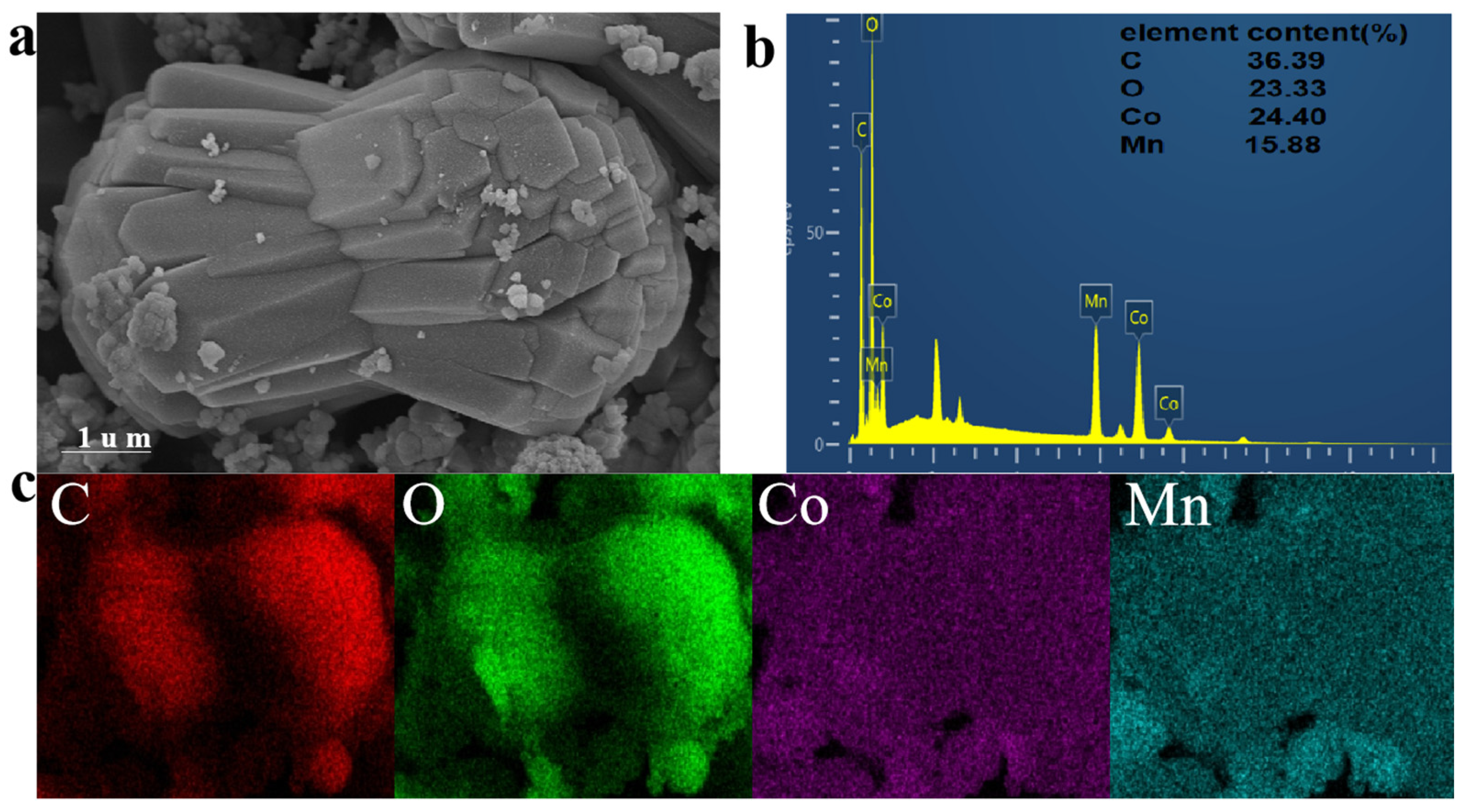
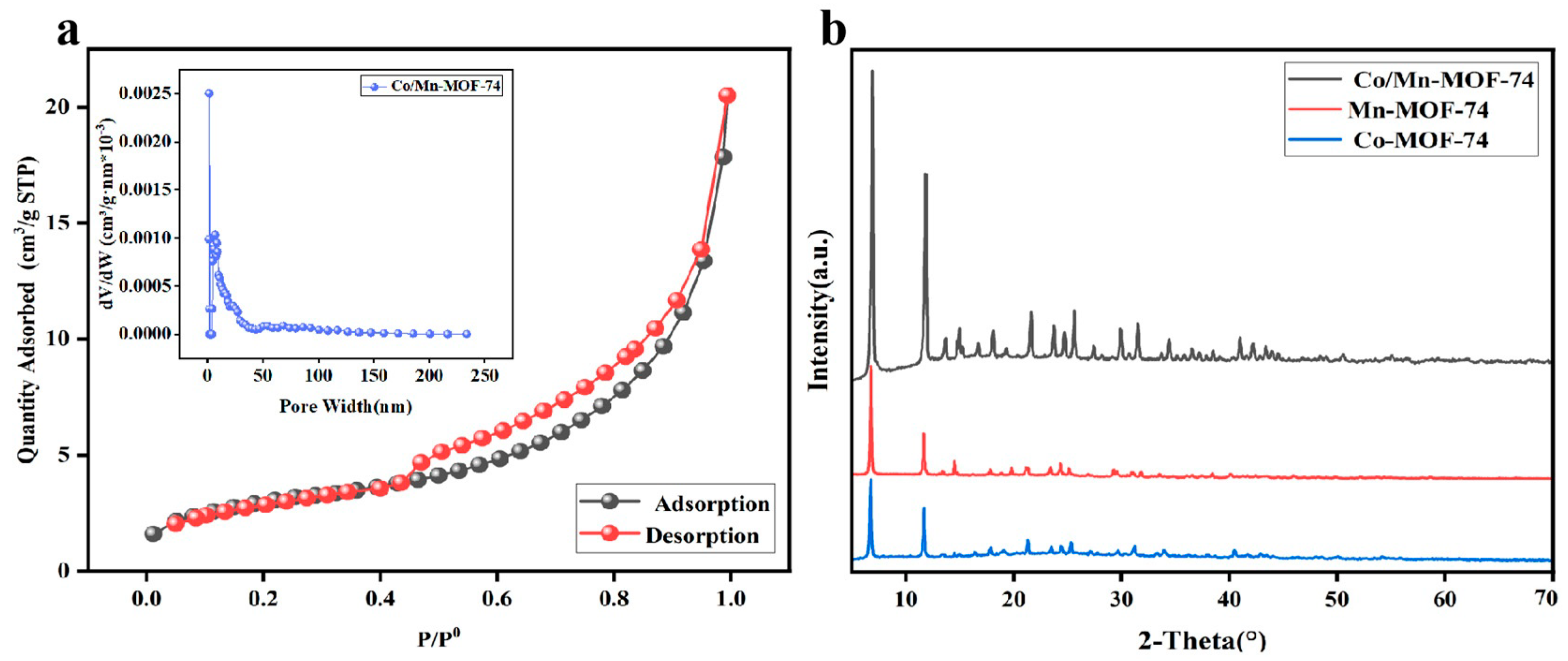
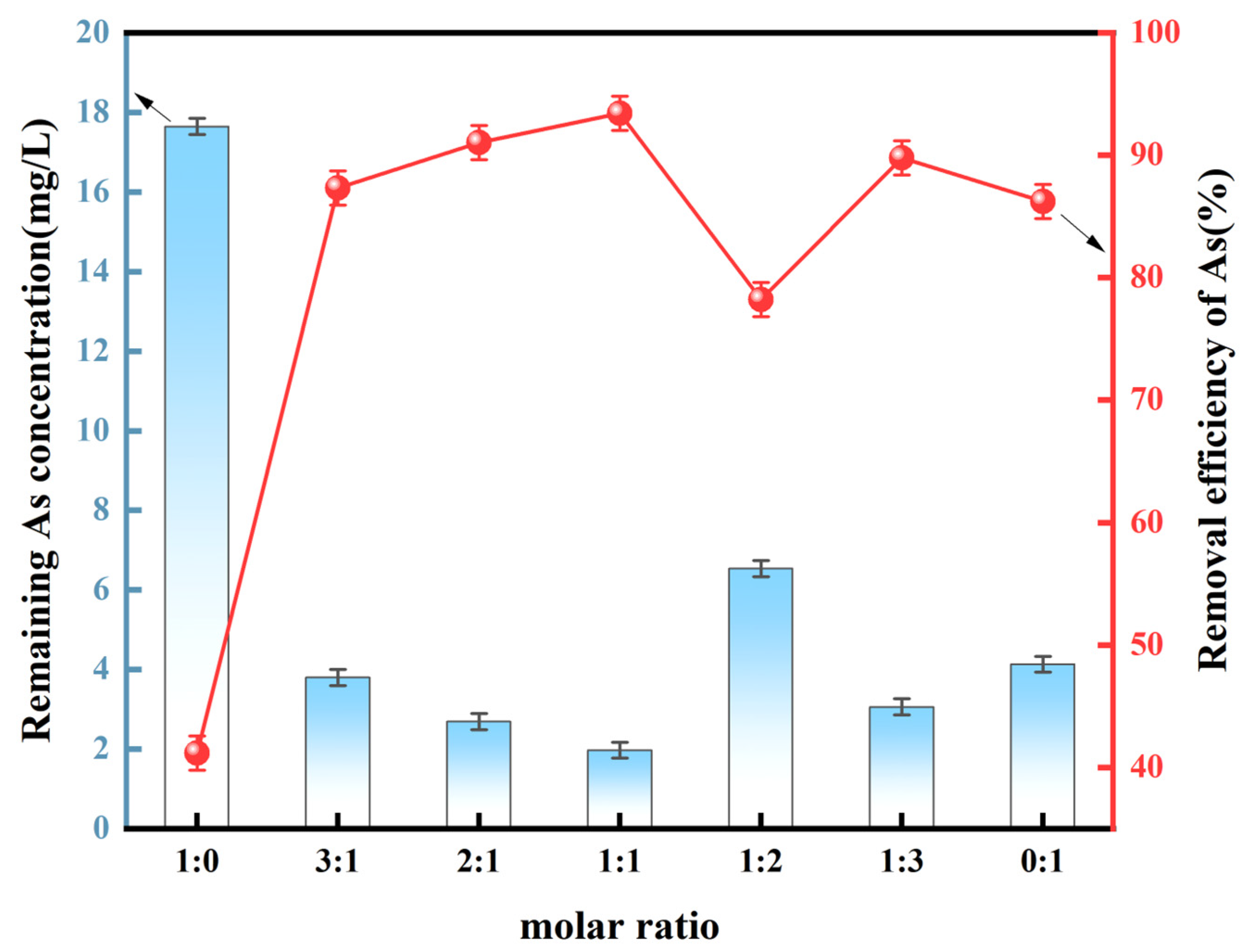
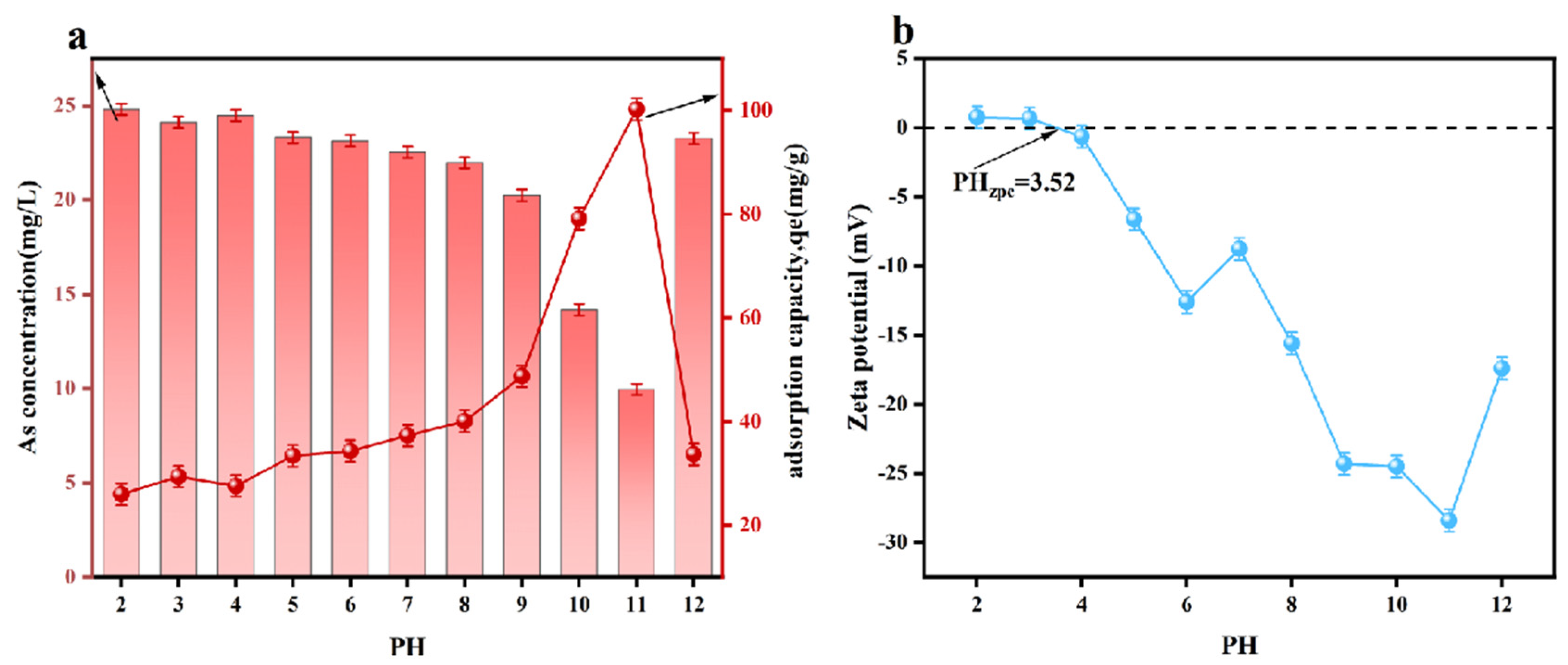
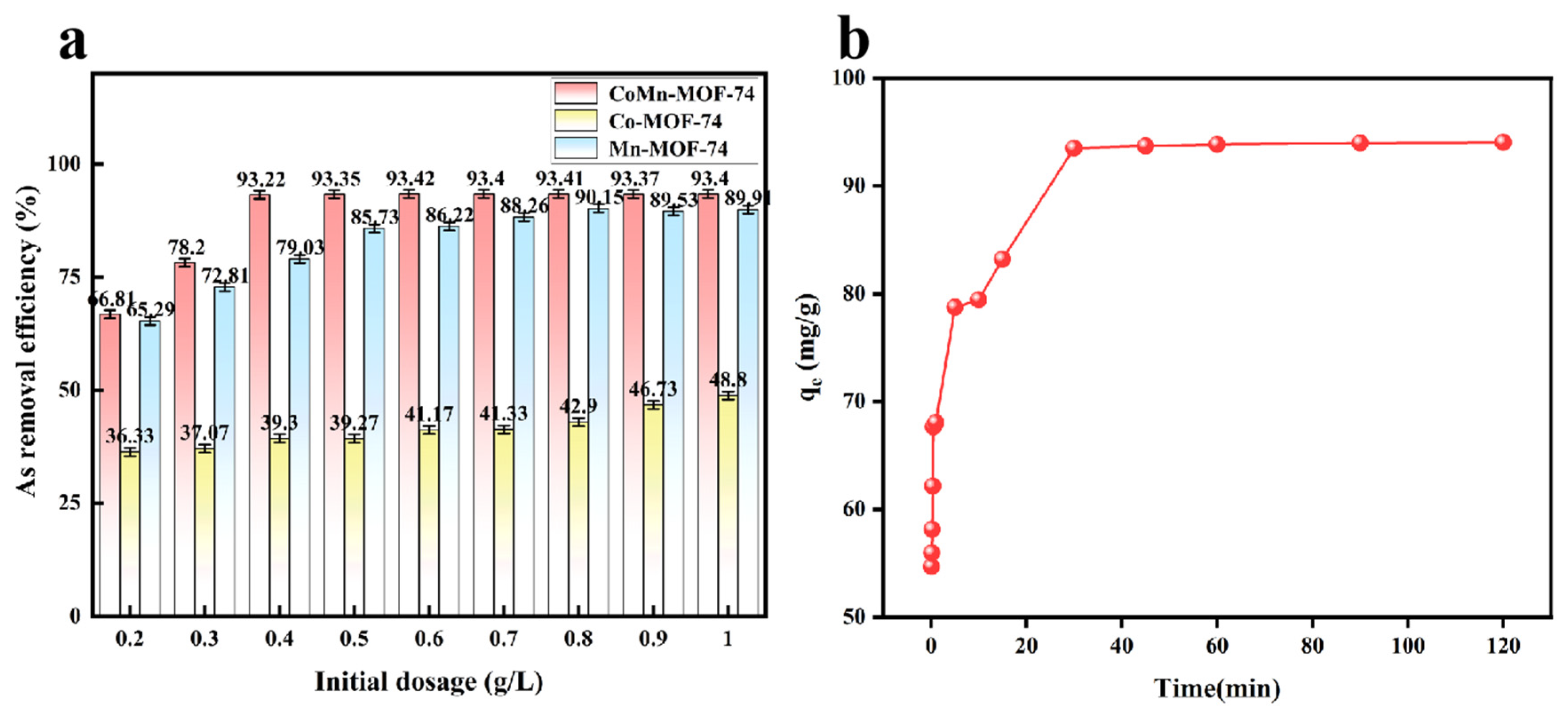
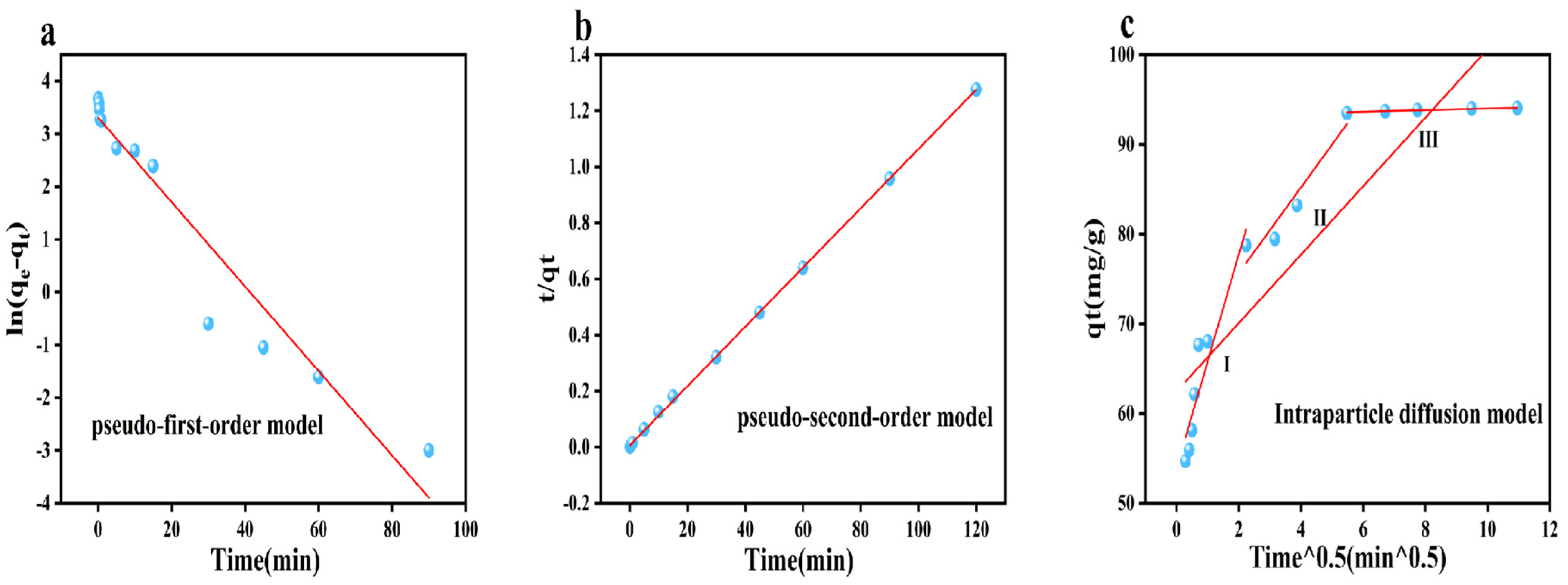
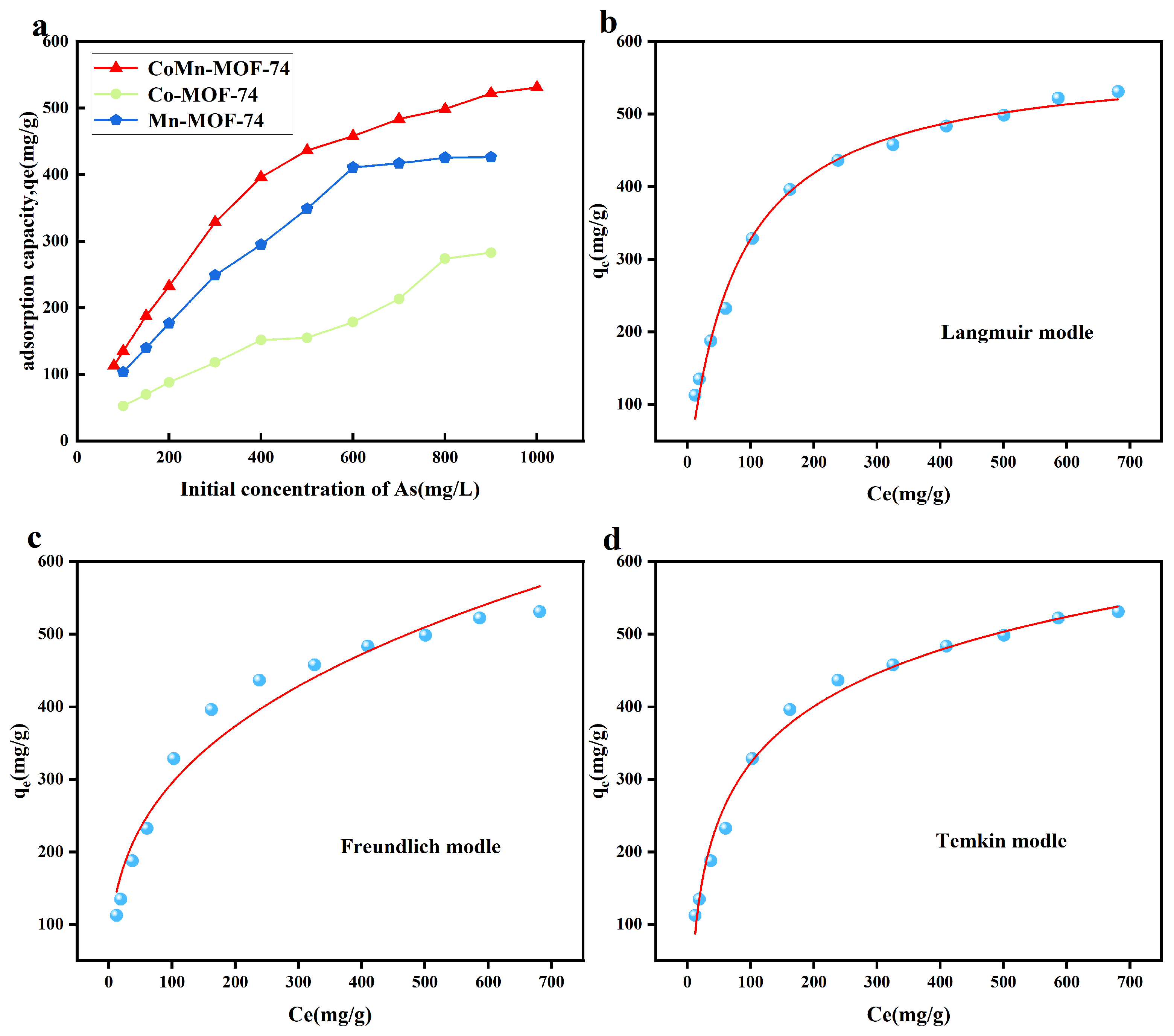

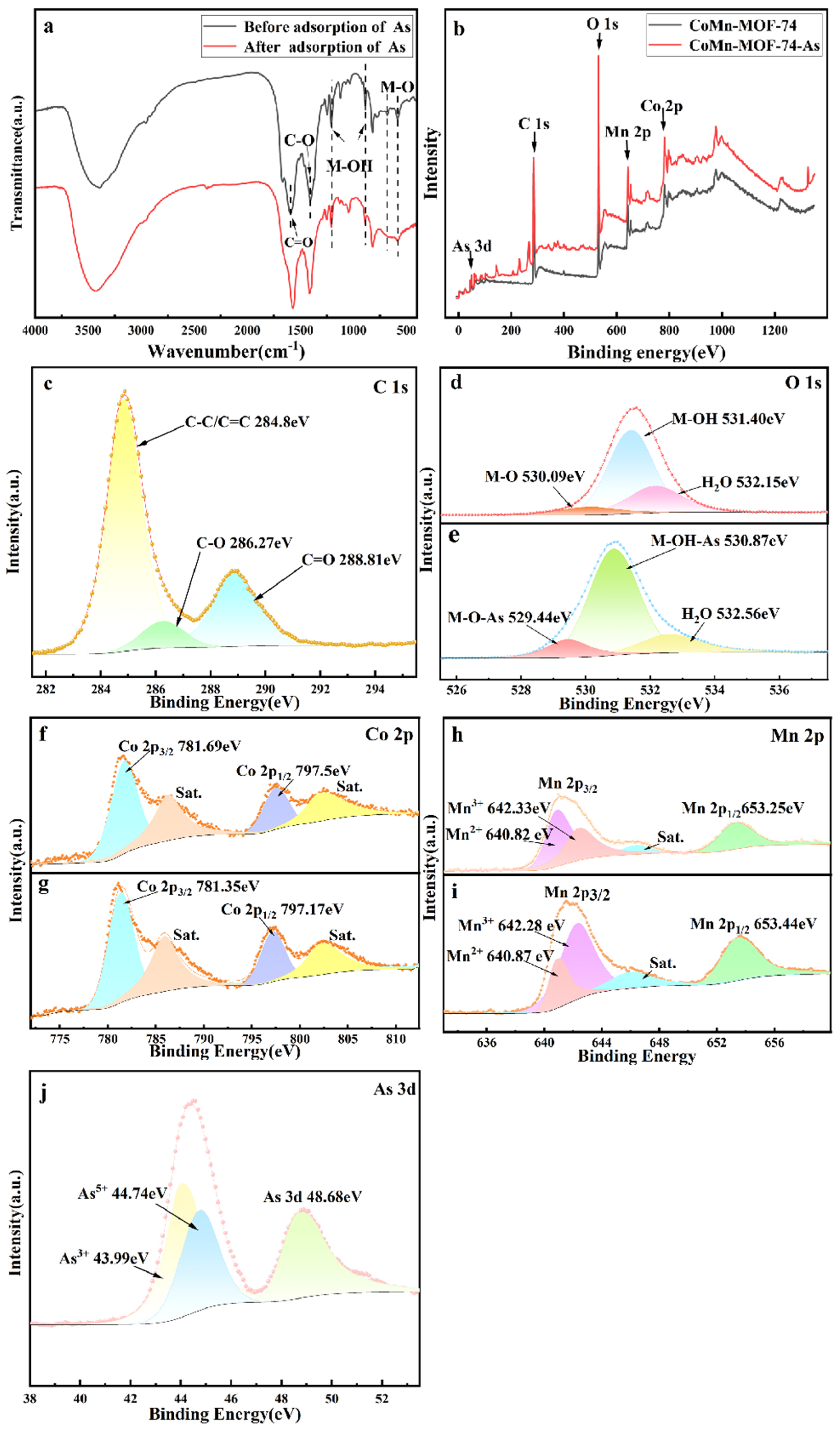
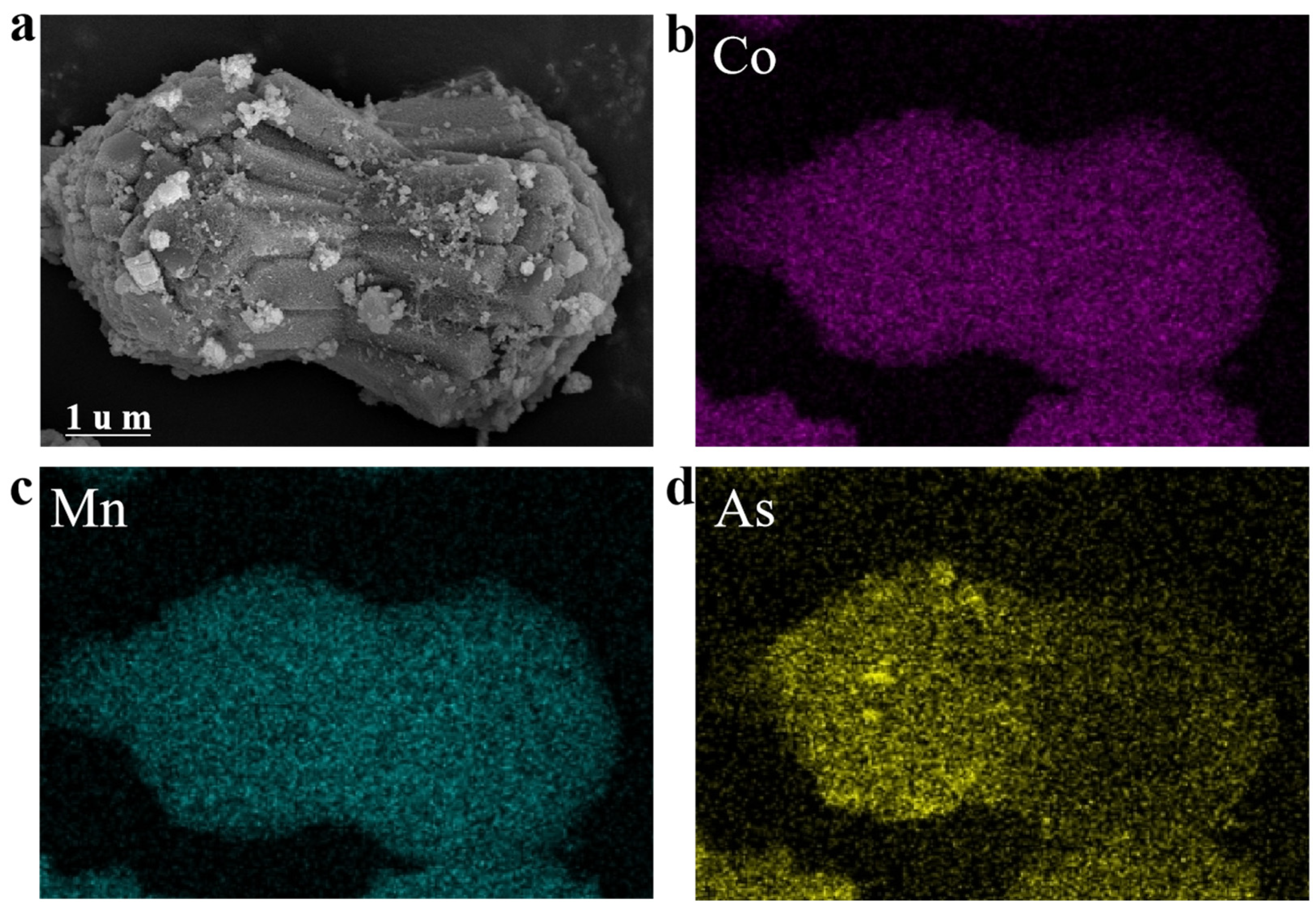
| Parameter | Value | |
|---|---|---|
| Pseudo-first-order | K1 | 0.0062 |
| 0.93818 | ||
| Pseudo-second-order | K2 | 0.01058 |
| 0.99973 |
| Absorbents | Langmuir | Freundlich | Temkin | |||
|---|---|---|---|---|---|---|
| R2 | K | R2 | K | R2 | K | |
| CoMn-MOF-74 | 0.99119 | 233.87713 | 0.96288 | 985.47731 | 0.98835 | 309.39143 |
Disclaimer/Publisher’s Note: The statements, opinions and data contained in all publications are solely those of the individual author(s) and contributor(s) and not of MDPI and/or the editor(s). MDPI and/or the editor(s) disclaim responsibility for any injury to people or property resulting from any ideas, methods, instructions or products referred to in the content. |
© 2025 by the authors. Licensee MDPI, Basel, Switzerland. This article is an open access article distributed under the terms and conditions of the Creative Commons Attribution (CC BY) license (https://creativecommons.org/licenses/by/4.0/).
Share and Cite
Feng, J.; Zhi, G.; Qi, X.; Geng, M. Efficient Adsorption of Arsenic from Smelting Wastewater by CoMn-MOF-74 Bimetallic Composites. Sustainability 2025, 17, 3060. https://doi.org/10.3390/su17073060
Feng J, Zhi G, Qi X, Geng M. Efficient Adsorption of Arsenic from Smelting Wastewater by CoMn-MOF-74 Bimetallic Composites. Sustainability. 2025; 17(7):3060. https://doi.org/10.3390/su17073060
Chicago/Turabian StyleFeng, Junwei, Gang Zhi, Xianjin Qi, and Mengmeng Geng. 2025. "Efficient Adsorption of Arsenic from Smelting Wastewater by CoMn-MOF-74 Bimetallic Composites" Sustainability 17, no. 7: 3060. https://doi.org/10.3390/su17073060
APA StyleFeng, J., Zhi, G., Qi, X., & Geng, M. (2025). Efficient Adsorption of Arsenic from Smelting Wastewater by CoMn-MOF-74 Bimetallic Composites. Sustainability, 17(7), 3060. https://doi.org/10.3390/su17073060






